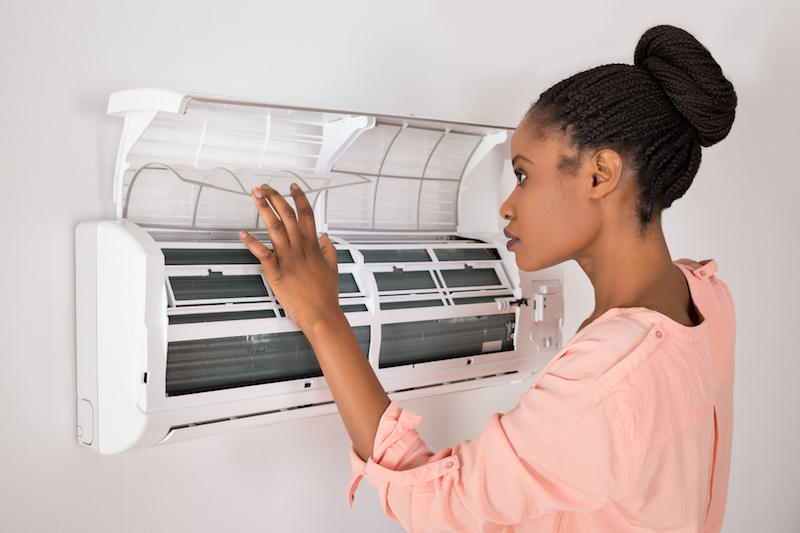
You shouldn’t have to give up comfort or drain your wallet to keep your residence at a pleasant temperature during warm days.
But what is the ideal setting, exactly? We go over suggestions from energy pros so you can select the best temperature for your house.
Here’s what we recommend for the most energy-efficient setting for air conditioning in Ellsworth.
Recommended Thermostat Settings for Summer
Most households find setting the thermostat at 72-73 degrees is ideal. However, if there’s a huge difference between your interior and exterior temps, your AC bills will be larger.
These are our recommendations based on the U.S. Department of Energy (DOE) and ENERGY STAR®.
While at home: 78 degrees. While that seems hot, there are approaches you can keep your home cool without having the air conditioner running constantly.
Keeping windows and blinds shut during the day keeps cool air where it needs to be—indoors. Some window treatments, such as honeycomb shades or plantation shutters, are made to give more insulation and better energy savings.
If you have ceiling fans in your residence, the DOE says you can raise thermostat temperatures about 4 degrees warmer without giving up comfort. That’s due to the fact they cool with a windchill effect. Because they cool people, not areas, turn them off when you exit a room.
If 78 degrees still seems too uncomfortable initially, try running a test for approximately a week. Begin by increasing your setting to 78 degrees while you’re at your house. Then, progressively decrease it while using the ideas above. You could be amazed at how cool you feel at a higher temperature setting.
While away: 88 degrees. There’s no reason to keep the air conditioner going all day while your home is unoccupied. Switching the temp 7–10 degrees warmer can save you anywhere from 5–15% on your electricity costs, according to the DOE.
When you arrive home, don’t be tempted to set your thermostat under 78 to cool your house more quickly. This isn’t useful and typically results in a higher electrical bill.
A programmable thermostat is a good approach to keep your settings under control, but you have to set programs. If you don’t use programs, you run the risk of forgetting to change the set temperature when you leave.
If you need a hassle-free fix, think over getting a smart thermostat. This thermostat works with with your phone, so it knows when you’re at home and when you’re out. Then it instinctively adjusts temperature settings for maximum savings. How much exactly? About $180 annually on heating and cooling, according to ENERGY STAR.
Another benefit of installing a smart thermostat? You can use your phone to keep an eye on and adjust temperature settings from almost anywhere.
While sleeping: Around 70 degrees. While ENERGY STAR suggests 82 degrees, that could be unbearable for the majority of families. Many people sleep better when their sleeping area is chilly, so that’s why the National Sleep Foundation recommends 60–67 degrees. But that may be too chilly, depending on your pajama and blanket preference.
We suggest running a comparable test over a week, moving your temp higher and steadily lowering it to locate the ideal temp for your house. On cool nights, you could discover keeping windows open at night and running a ceiling fan is a better solution than operating the air conditioner.
More Approaches to Conserve Energy During Hot Weather
There are extra ways you can conserve money on cooling bills throughout hot weather.
- Install an energy-efficient air conditioning system. Central air conditioners only last about 12–15 years and get less efficient as they become older. An upgraded air conditioner can keep your house comfier while keeping energy costs low.
- Schedule annual air conditioner service. Regular air conditioner maintenance keeps your system running like it should and may help it run at greater efficiency. It could also help extend its life expectancy, since it allows pros to spot small problems before they create a major meltdown.
- Put in new air filters frequently. Read manufacturer instructions for switching your air filter. A dusty filter can lead to your system short cycling, or switch on and off too often, and increase your electrical.
- Check attic insulation levels. Nearly 90% of homes in the U.S. don’t have adequate insulation, according to the Insulation Institute. Many southern climates should have 13–14” of attic insulation, while northern climates should have 16–18”.
- Have your ductwork examined. Ductwork that has loosened over time can leak conditioned air into your attic, walls or crawl space. This can lead to huge comfort troubles in your home, such as hot and cold spots.
- Seal cracks, doors and windows. Keep humid air in its place by closing cracks. You can also caulk or weather strip doors to trap more cold air indoors.
Use Less Energy During Hot Weather with Walter's-Eaton's Electric, Plumbing, Heating & AC
If you are looking to conserve more energy during warm weather, our Walter's-Eaton's Electric, Plumbing, Heating & AC experts can help. Get in touch with us at 715-318-6728 or contact us online for extra info about our energy-saving cooling options.

